Class 11 Biology Sample Question Paper with Solution- 1 | Sample Papers for Class 11 Medical and Non-Medical - JEE PDF Download
SECTION A
Ques 1: What are the names given to the male and female sex organs of algae? [1]
OR
Why are bryophytes called amphibians of the plant kingdom?
Ans: Male – Antheridia; Female – Oogonia
OR
Bryophytes can live on land but depend on water for sexual reproduction. Hence, bryophytes are called amphibians of the plant kingdom.
Ques 2: What is meant by a sheathing leaf base? [1]
Ans: When the leaf base expands into a sheath covering the stem partially or wholly, it is called a sheathing leaf base.
Ques 3: What is the function of the nucleolus? [1]
Ans: The nucleolus is the site of active ribosomal RNA synthesis.
Ques 4: Mention one similarity between transport proteins and enzyme proteins. [1]
OR
What is the function of catalase?
Ans: They are specific for a substance.
OR
Catalase catalyses the breakdown of hydrogen peroxide into water and oxygen.
Ques 5: The proximal end of a nephron is closed. What is this modification? [1]
Ans: Bowman’s capsule
SECTION B
Ques 6: What is the difference between the two body forms—polyp and medusa—exhibited by cnidarians? [2]
Ans: Cnidarians exhibit two body forms—polyp and medusa.
| Polyp | Medusa |
The polyp form is sessile and cylindrical. ii. Example: Hydra | The medusa form is umbrella-shaped and free-swimming. ii. Example: Aurelia |
Ques 7: Mention two factors on which imbibition depend. [2]
OR
List four sinks for mineral elements or ions in plants.
Ans: The amount of imbibition depends on
i. The water potential gradient between the adsorbent and the liquid/water imbibed.
ii. The affinity between the absorbent and the imbibed liquid.
OR
Sinks for mineral elements or ions in plants:
- Apical and lateral meristems
- Young leaves
- Storage organs
- Developing flowers, fruits and seeds
Ques 8: What is the role of antennae pigments of LHC? [2]
Ans: They absorb the different wavelengths of light and pass on the energy to the reaction centre.
Ques 9: (a) Who proposed the double helical model of DNA?[2]
(b) Why are the two strands of DNA described as antiparallel?
OR
(a) Name any four sites where ribosomes are present in plant cells.
Ans:(a) Watson and Crick proposed the double helical model of DNA.
(b) The two strands are antiparallel because they run in opposite directions, one in the 5′–3′ direction and the other in the 3′–5′ direction.
OR
i) Freely in the cytoplasm
ii) Attached to ER in the cytoplasm
iii) Inside mitochondria
iv) Inside plastids
Ques 10: Differentiate between red algae and brown algae. [2]
Ans: Differences between red algae and brown algae:
| Red algae | Brown algae |
1. They have a characteristic pigment– phycoerythrin. | 1. They have a characteristic pigment– fucoxanthin. |
2. They do not have any flagellated or motile structures. | 2. They have flagellated gametes and zoospores. |
3. Reserve food material is in the form of floridean starch. | 3. Reserve food material is in the form of laminarin and mannitol. |
4. Agar and carrageen are the phycocolloids. | 4. Algin is the phycocolloid. |
Ques 11: Name the kind of tissue which [2]
i) stores starch in potato
ii) forms the shell in nuts
Ans: i) stores starch in potato - Parenchyma
ii) forms the shell in nuts - Sclerenchyma
Ques 12: How are amino acids in a protein held together? [2]
Ans: Amino acids in a protein are held together by a peptide bond which is formed when the carboxyl (-COOH) group of one amino acid reacts with the amino (-NH2) group of the next amino acid with the elimination of a water molecule.
SECTION C
Ques 13: Name the type of fertilisation which is unique to angiosperms. Describe it. [3]
Ans: Double fertilisation is unique to angiosperms. In this phenomenon, two male gametes are discharged by a pollen tube into the embryo sac of an ovule. One male gamete fuses with the female gamete to form a zygote. This fusion is called syngamy. A second male gamete fuses with the secondary nucleus to form the primary endosperm nucleus. This is called triple fusion.
Ques 14: Underground parts of a plant are not always roots. Comment. [3]
OR
Mention the characteristics of the cells in the region of the meristem in roots.
Ans: The underground parts of a plant are not always roots because
i) Plants such as potato, ginger, onion and Colocasia have underground stems.
ii) Underground stems show nodes and internodes.
iii) They also have terminal buds and axillary buds.
OR
Characteristics of the cells in the region of the meristem in roots:
- Small in size
- Thin-walled
- Dense protoplasm
- Divide repeatedly
Ques 15: Answer the following with reference to the anatomy of dicot root: [3]
i) Where is the pericycle located?
ii) How are xylem vessels arranged?
iii) What do you call such an arrangement?
Ans: i) The pericycle is positioned just inner to the endodermis.
ii) The protoxylem elements are towards the external surface, while the metaxylem
elements are found towards the core.
iii) Such an arrangement of the xylem is called exarch.
Ques 16: Draw a labelled diagram of the alimentary canal of a cockroach. [3]
Ans: Alimentary canal of cockroach: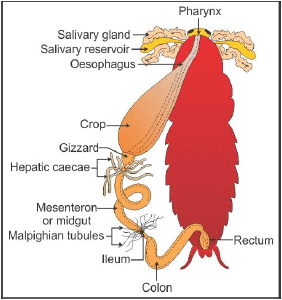
Ques 17: What do you understand by the cytoskeleton present in the cell? What function
does it perform? [3]
OR
Differentiate between primary cell wall and secondary cell wall.
Ans: The cytoskeleton is an elaborate network of filamentous proteinaceous structures present in the cytoplasm.
Functions of the cytoskeleton:
i) Cytoskeletal structures maintain the shape of the cell and its extensions.
ii) It regulates the orientation and distribution of cell organelles.
iii) It helps in the intracellular transport and movement of cells.
OR
Differences between primary cell wall and secondary cell wall:
| Primary cell wall | Secondary cell wall |
|
|
|
|
|
|
Ques 18: Find examples where the four daughter cells formed from meiosis are equal in size and where they are found unequal in size. [3]
Ans: i) The four microspores formed by meiosis in a microspore mother cell are equal.
ii) The four spermatids formed from a spermatocyte are equal.
iii) When a primary oocyte undergoes meiosis I, a large secondary oocyte and a small cell, the polar body, are formed.
Ques 19:Explain the terms: [3]
i) Monoglyceride
ii) Diglyceride
iii) Triglyceride
Ans: i) Monoglyceride is a lipid with one molecule of glycerol and one molecule of fatty acid.
ii) Diglyceride is a lipid with one molecule of glycerol and two molecules of fatty acids.
iii) Triglyceride is a lipid with one molecule of glycerol and three molecules of fatty acids.
Ques 20: What are the two crucial events in aerobic respiration? Where do these take place? [3]
Ans: The important events in aerobic respiration are
i) The complete oxidation of pyruvate by the step-wise removal of all the hydrogen atoms with the release of three molecules of carbon dioxide.
ii) The passing on the electrons removed as part of the hydrogen atoms to molecular O2 along with the synthesis of ATP.
The first step takes place in the matrix of the mitochondria, while the second step occurs in the inner membrane of the mitochondria.
Ques 21: How does oxidative phosphorylation differ from photophosphorylation? Explain. [ 3]
OR
Answer the following questions with reference to nitrogen:
i) The form in which it is absorbed from the soil.
ii) In which part of the plant is it required?
iii) Two organic compounds in which it is a component.
Ans: Net products of glycolysis:
i) In glycolysis, two molecules of ATP are consumed during double phosphorylation of glucose to form fructose 1, 6 biphosphate.
ii) Four molecules of ATP are produced by substrate-level phosphorylation (conversion of 1, 3 biphosphoglycerate to 3-phosphoglycerate and phosphoenolpyruvate to pyruvate).
iii) Two molecules of NADH2 are formed at the time of oxidation of glyceraldehyde 3-
phosphate to 1, 3 biphosphoglycerate.
iv) The net reaction is as follows:
Glucose +2NAD+ +2 ADP +2H3 PO4 2 pyruvate + 2 NADH + 2H+ + 2 ATP
v) Each NADH is equivalent to 3 ATP, so that the net gain in glycolysis is 8 ATP.
OR
i) It is absorbed as NO3−, NO2− and NH4+ ions.
ii) It is required in the meristematic tissues and metabolically active cells.
iii) It is a constituent of nucleic acids, amino acids, vitamins, proteins etc.
Ques 22: i) Explain how the thoracic chamber is a closed chamber.
ii) Why is such a setup necessary?
iii) Why is the larynx called the sound box?
Ans: i) The thoracic chamber is a closed chamber. It is formed dorsally by the vertebral column. The ventral side is formed by the sternum. It has ribs on the lateral side, and the lower side is formed by a dome-shaped diaphragm.
ii) It is necessary because any change in the volume of the thoracic cavity will be reflected in the pulmonary cavity.
iii) The larynx is called the sound box because it has vocal cords which vibrate to produce sound.
Ques 23: How does progesterone function in a human female? [3]
OR
Mention any four activities regulated by oestrogen hormone.
Ans: i) Progesterone helps to maintain pregnancy.
ii) It stimulates the secretion of milk.
iii) Its secretion is influenced by the luteinising hormone of the anterior pituitary.
OR
Activities regulated by oestrogen hormone:
- Growth and functions of the female secondary sex organs
- Appearance of female sexual characters
- Development of mammary glands
- Development of ovarian follicle
- Female sexual behaviour
Ques 24: What are the factors affecting the rate of diffusion?
Ans: Factors affecting the rate of diffusion:
- Concentration gradient
- Permeability of the membrane
- Properties of the substance
- Temperature
- Pressure
SECTION D
Ques 25: Give the diagrammatic representation of ETS and explain. [5]
OR
(a) With the help of well-labelled diagrams, describe the process of plasmolysis in plants giving appropriate examples.
(b) Explain what will happen to a plant cell if it is kept in a solution with higher water potential.
Ans: An electron transport system (ETS) is a series of coenzymes and cytochromes which take part in the passage of electrons from a chemical to its ultimate acceptor.
The passage of electrons from one enzyme or cytochrome to the next is accompanied with the loss of energy at each step. At each step, the electron carriers include flavins, iron sulphur complexes, quinones and cytochromes. The inner mitochondrial membrane possesses five complexes. Complex V is concerned with ATP synthesis. Complexes I to IV are involved in electron transport. These complexes are arranged in a definite sequence in the inner mitochondrial membrane. Reduced coenzymes transfer their electrons and protons through ETS in the following manner:
i) Transfer of hydrogen from NADH + H+ to metalloflavoprotein-FMN (flavin mononucleotide). FMN gets reduced to FMNH2 and the coenzyme NADH+H+ gets oxidised to NAD+. Oxidation of NADH occurs by complex I.
ii) Reduced FMN (i.e. FMNH2) then transfers its electrons to Fe–S protein (iron sulphur protein) and 2H+ into the inner membrane space.
iii) The reduced Fe–S protein then transfers its electrons to ubiquinone (UQ). UQ takes two electrons from Fe–S protein and two protons (2 H+) from the matrix to become UQH2.
iv) Reduced ubiquinone (UQH2) then transfers its electrons to cytochrome b and 2 H+ to the other side into the inner membrane space. FADH2 reduced in the Krebs cycle also enters through complex II into ETS by transferring its 2 H to UQ. UQ is reduced to UQH2.
v) NADH+H+ reduced in glycolysis also enters ETS. NADH reduces a flavoprotein containing NADH-dehydrogenase located on the outer surface of the inner mitochondrial membrane.
vi) The reduced flavoprotein (FPH2) then enters the main pathway by transferring 2 H to UQ. The reduced UQ then transfers its electrons to complex III and 2 H+ to the outer side.
vii) Reduced cytochrome b then transfers its electrons to Fe–S protein. The Fe3+–S is converted to Fe2+–S. This protein transfers electrons to UQ which also takes 2 H+ from the inner matrix to become UQH2.
viii. The reduced UQ (i.e. UQH2) transfers its electrons to cytochrome c1 and a third pair of H+ is transported outwardly.
ix. Reduced cytochrome c1 then reduces cytochrome c by transferring its electrons.
x. The electrons from cytochrome c are then transferred to O2 via cyt a and cyt a3.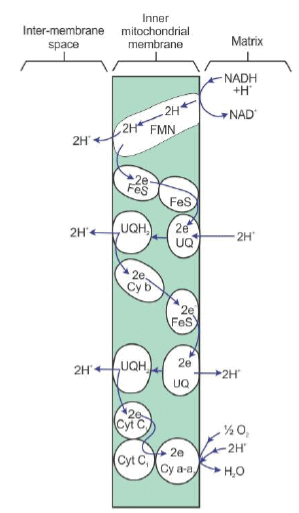
OR
(a) Plasmolysis is the shrinkage of the protoplast from the cell wall under the influence of a hypertonic solution.
If a plant cell is placed in a highly concentrated sugar or salt solution, water from the cell sap flows out due to exosmosis through the plasma membrane outside the cell.
This causes contraction or shrinkage of the protoplast. Because the cell wall has very less elasticity, it cannot keep pace with the contraction of the plasma membrane. Ultimately, the protoplasm separates from the cell wall and assumes a spherical shape. This condition is called plasmolysis.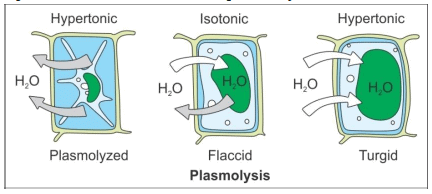
(b) Higher water potential occurs in a hypotonic or dilute solution. A plant cell present in such a solution will absorb water due to endosmosis. It will become turgid or swollen. The swollen protoplast develops a wall pressure which becomes equal to the water potential of the system which causes endosmosis to stop.
Ques 26: (a) List the functional areas of the cerebral hemisphere and write one function of each.
(b) Draw a labelled diagram of a neuron.
OR
(a) Describe briefly the three parts of the large intestine.
(b) Draw a diagram of the human stomach and label its parts.
(c) What is peristalsis?
Ans: (a) In each cerebral hemisphere, the cerebral cortex contains three types of functional areas:
i) Sensory areas: They receive impulses from the receptors.
ii) Motor areas: They transmit impulses to the effectors.
iii) Association areas: They interpret the input, store the input and initiate a response in light of similar experience; thus, they are responsible for
intersensory associations, memory and communication.
(b)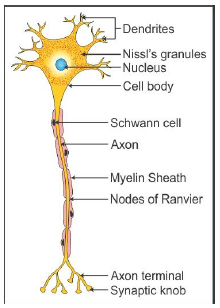
OR
(a) The large intestine whose diameter is larger than that of the small intestine is about 1.5 metres long and divisible into three parts:
i) Caecum: It is a small blind sac which harbours some symbiotic microorganisms. The vermiform appendix is a vestigial organ which arises from the caecum. The caecum opens into the colon.
ii) Colon: The colon is divided into three parts—ascending, transverse and descending. The descending part opens into the rectum through the sigmoid colon.
iii) Rectum: The rectum comprises the last 20 centimetres of the digestive tract and terminates in the 2-centimetre long anal canal. The opening of the anal canal is called the anus.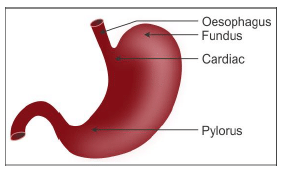
(c) Peristalsis refers to the involuntary contractions of smooth muscles which spread like waves along the muscles.
Ques 27: Name the components of the formed elements in the blood and mention one major function of each of them. [5]
OR
Describe the process of digestion of carbohydrates in the human alimentary canal.
Ans: Formed elements in the blood include erythrocytes, leucocytes and thrombocytes.
(a) Erythrocytes: Haemoglobin present in the erythrocytes transport oxygen and carbon dioxide.
(b) Leucocytes:
- Lymphocytes present in the leucocytes are involved in the immune response of the body.
- Neutrophils and monocytes are phagocytic in nature. They destroy any foreign organism and provide protection against infection.
- Basophils are involved in inflammatory reactions.
- Eosinophils are associated with allergic reactions.
(c) Thrombocytes:
- They are involved in the coagulation of blood during an injury and thus prevents excess loss of blood.
OR
Process of digestion of carbohydrates in the human alimentary canal:
- Digestion of carbohydrates begins in the mouth.
- 30% of the starch is hydrolysed into maltose by the enzyme salivary amylase.
- The action of salivary amylase is inhibited by the hydrochloric acid present in the stomach.
- Digestion of starch continues in the intestine; the remaining 70% of the starch is hydrolysed by pancreatic amylase into maltose.
- Maltose and other sugars are digested by the enzymes called disaccharides of the intestinal juice (succus entericus).
- Sucrose is acted upon by sucrase and broken into one molecule of glucose and one molecule of fructose.
- Maltose is hydrolysed by maltase into two molecules of glucose.
- Lactase acts upon the milk sugar lactose and breaks it into one molecule of glucose and one molecule of galactose.
- The final products of carbohydrate digestion are monosaccharides like glucose, fructose and galactose.
FAQs on Class 11 Biology Sample Question Paper with Solution- 1 - Sample Papers for Class 11 Medical and Non-Medical - JEE
| 1. What are the main topics covered in Class 11 Biology? |  |
| 2. Which book is recommended for Class 11 Biology preparation? |  |
| 3. How can I improve my understanding of Biology concepts? |  |
| 4. Are there any important diagrams or illustrations that I should focus on for the Class 11 Biology exam? |  |
| 5. What are some effective study tips for Class 11 Biology? |  |














